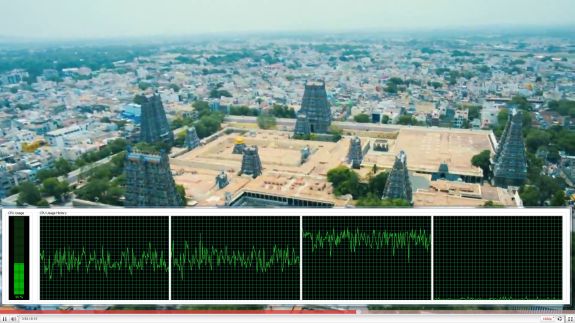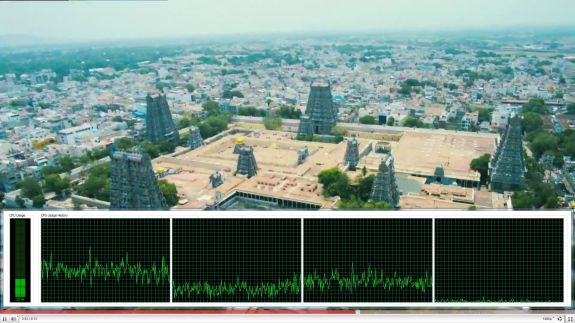ASRock Core 100HT-BD : Bringing HTPCs to the Mainstream Market [UPDATED : Noise Issue]
by Ganesh T S on July 19, 2010 9:34 PM EST- Posted in
- Home Theater
- Arrandale
- ASRock
- Media Streamer
- Core i3
- HTPC
The Core 100 HT-BD is well off from the networking perspective. It really doesn't matter if the unit is within reach of a wired network or not. We carried out all our tests with a 150 Mbps Draft-N wireless network. Despite being unable to utilize the maximum transfer rates available on the Core 100 HT-BD, we were easily able to stream HD clips of more than 50 Mbps. HD YouTube videos and HD Netflix streaming had no issues.
While on the topic of network streaming, let us take a brief look at how the system performs while accessing online video services. The first set of screenshots below show the CPU usage while playing back a 1080p YouTube video with and without hardware acceleration enabled. As can be seen, the GPU indeed supports Flash acceleration. Enabling hardware acceleration almost halved the CPU usage. Dedicated GPUs from ATI and Nvidia might result in lesser CPU usage. However, one is not really upset at having just 20% CPU utilization for a 1080p HD video. We expect similar results for videos on Hulu.
Netflix streaming, on the other hand, uses Microsoft's Silverlight technology. Unlike Flash, hardware acceleration for the video decode process is not controlled by the user. It is upto the server side code to attempt GPU acceleration. Thankfully, Netflix does try to take advantage of the GPU's capabilities. This is evident from the A/V stats recorded while streaming a Netflix HD video at the maximum possible bitrate of 3.8 Mbps. While the video is definitely not 1080p, we observe that the CPU utilization of around 30% is higher than the CPU usage for a 1080p YouTube video.
We suspect that the handling of the DRM in the case of Netflix streaming is done by the CPU, resulting in the higher usage. In any case, 30% CPU utilization for streaming the highest bit rate Netflix videos is not bad.
Users of media streamers streaming online videos often have to put up with messages of the sort 'This content is not available on TV connected devices' or need to queue up the videos on a PC before accessing them through their media streamer box. HTPC users don't need to worry about any such limitations. On the whole, the Core 100 HT-BD is a big winner from the network streaming standpoint.













107 Comments
View All Comments
spddemon - Tuesday, July 20, 2010 - link
This system is capable of dobly truHD and DTS HD. A ION system is not capable of decoding of those sounds format...So this system will appeal heavily to someone that wants a small nettop type system with a BD and good encoding performance. With any nettop you are going to have to use NAS storage anyways, but this system will allow more internal expansion than most others.. But if you wanted to, you could pair it with an external drive cage.. I wouldn't want that in my living room / theater room though.
biggest problem with this system is price.. You can build a great system for a couple hundred less if you are willing to take hours of researching the components and integration. A successful HTPC build will take considerable more time in planning/research than a typical PC/Gaming PC Build....
If you are wanting a powerful, small, efficient, prebuilt nettop, this is the best out there right now!
That is really the only thing i wish Ganesh would of pointed out a little more clearly. The capabilities of the "iGPU" vs an ION.. with the growth of this field, I would love to see a followup review that would pit a custom built (but comparable build) HTPC.. like a Core i3 530 (or maybe an e7200) / H55 with and without an ATI/NVIDIA (non ION) card. This would really give some people something to look at as far as capabilities..
and really, who cares what the remote looks like.. get a Logitech harmony or some other home automation remote... most people will only care about if the IR or RF functionality is already there...
ganeshts - Tuesday, July 20, 2010 - link
spddemon,Stay tuned for more HTPC reviews in this space. Their performance will be pitted against this solution.
However, ION is passe right now. We will be testing with the ATI 5xxx series and upcoming Nvidia cards.
Furuno - Wednesday, July 21, 2010 - link
Upcoming nVidia cards...Hmm I wonder what it is... A low-cost version of fermi or another rebranding of GT2XX cards?
ganeshts - Wednesday, July 21, 2010 - link
We already published reviews of the GTX460 from the gaming perspective.The card is good from a gaming HTPC perspective because it also supports HD audio bitstreaming.
There are some rumours that Nvidia has lower priced cards coming out in the next 2 months, so we will cover them when they get released :) At the least, we will cover the GTX460.
spddemon - Wednesday, July 21, 2010 - link
Thanks for the updates Ganeshts!It looks like your time frame will be perfect for my new HTPC project.
I really hope Nvidia can get some low powered cards out to offer a true HTPC card that covers all the current HD formats/codecs.
mindbomb - Wednesday, July 21, 2010 - link
Ion can only bitstream LPCM, but I assume the atom cpu is powerful enough to decode truehd in libavcodec.So that only leaves DTS-HD MA as a problem.
ganeshts - Tuesday, July 20, 2010 - link
Goty,The user can always opt for a USB TV tuner.
If we had an expansion slot for a TV tuner inside this box, the unit wouldn't be based off the HM55 chipset, and wouldn't fit in the sub-50 W power envelop which is a coveted mark in this space.
Further, including a TV tuner in the box would drive up the cost of the system in some areas, as it would be taxed as an entertainment device, rather than a computer.
bearxor - Tuesday, July 20, 2010 - link
No one that is serious about using this as a HTPC is going to string USB TV tuners off this thing. You want 2 USB tuners hanging off the back of the machine? How about 4?My HTPC has 7 tuners total. 2xHauppage 2250's, 2xCats Eye 150's and a ATi DCT. Tell me exactly where I'm going to be able to put those on a machine like this.
There needs to be some kind of market differentiation between a HTPC and a Living Room PC. One is for serious use as a DVR and the other is to hook up to the TV and watch some videos/play games/surf the web/Facebook/chat, etc. They are two different markets.
ganeshts - Tuesday, July 20, 2010 - link
bearxor,You have got an impressive set up.
However, I believe your type of setup is more the exception rather than the norm. The sort of arrangement which will remain a niche for a long time to come. With the advent of IP streaming and availability of TV shows and live sports broadcasts online, I am not even sure people will require so many tuners.
I also think that your sort of setup isn't amenable to the silent, power efficient HTPC that people want (particularly from the viewpoint of media streamers and boxes such as the upcoming Google TV). The latter 'living room PC' that you mention has more potential to explode as a market for manufacturers to exploit, rather than the DVR-centric PC that you envisage.
hughlle - Tuesday, July 20, 2010 - link
Exactly, 7 tuners is hardly the norm. I make do without a single one on my HTPC, i have the likes of iplayer if i really feel inclined to drop into the fantastic realm that is daytime television :S